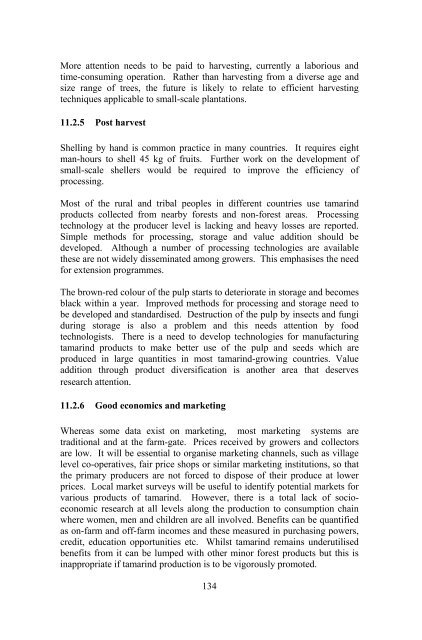Tamarind monograph.pdf - Crops for the Future
Tamarind monograph.pdf - Crops for the Future
Tamarind monograph.pdf - Crops for the Future
Create successful ePaper yourself
Turn your PDF publications into a flip-book with our unique Google optimized e-Paper software.
More attention needs to be paid to harvesting, currently a laborious and<br />
time-consuming operation. Ra<strong>the</strong>r than harvesting from a diverse age and<br />
size range of trees, <strong>the</strong> future is likely to relate to efficient harvesting<br />
techniques applicable to small-scale plantations.<br />
11.2.5 Post harvest<br />
Shelling by hand is common practice in many countries. It requires eight<br />
man-hours to shell 45 kg of fruits. Fur<strong>the</strong>r work on <strong>the</strong> development of<br />
small-scale shellers would be required to improve <strong>the</strong> efficiency of<br />
processing.<br />
Most of <strong>the</strong> rural and tribal peoples in different countries use tamarind<br />
products collected from nearby <strong>for</strong>ests and non-<strong>for</strong>est areas. Processing<br />
technology at <strong>the</strong> producer level is lacking and heavy losses are reported.<br />
Simple methods <strong>for</strong> processing, storage and value addition should be<br />
developed. Although a number of processing technologies are available<br />
<strong>the</strong>se are not widely disseminated among growers. This emphasises <strong>the</strong> need<br />
<strong>for</strong> extension programmes.<br />
The brown-red colour of <strong>the</strong> pulp starts to deteriorate in storage and becomes<br />
black within a year. Improved methods <strong>for</strong> processing and storage need to<br />
be developed and standardised. Destruction of <strong>the</strong> pulp by insects and fungi<br />
during storage is also a problem and this needs attention by food<br />
technologists. There is a need to develop technologies <strong>for</strong> manufacturing<br />
tamarind products to make better use of <strong>the</strong> pulp and seeds which are<br />
produced in large quantities in most tamarind-growing countries. Value<br />
addition through product diversification is ano<strong>the</strong>r area that deserves<br />
research attention.<br />
11.2.6 Good economics and marketing<br />
Whereas some data exist on marketing, most marketing systems are<br />
traditional and at <strong>the</strong> farm-gate. Prices received by growers and collectors<br />
are low. It will be essential to organise marketing channels, such as village<br />
level co-operatives, fair price shops or similar marketing institutions, so that<br />
<strong>the</strong> primary producers are not <strong>for</strong>ced to dispose of <strong>the</strong>ir produce at lower<br />
prices. Local market surveys will be useful to identify potential markets <strong>for</strong><br />
various products of tamarind. However, <strong>the</strong>re is a total lack of socioeconomic<br />
research at all levels along <strong>the</strong> production to consumption chain<br />
where women, men and children are all involved. Benefits can be quantified<br />
as on-farm and off-farm incomes and <strong>the</strong>se measured in purchasing powers,<br />
credit, education opportunities etc. Whilst tamarind remains underutilised<br />
benefits from it can be lumped with o<strong>the</strong>r minor <strong>for</strong>est products but this is<br />
inappropriate if tamarind production is to be vigorously promoted.<br />
134

















